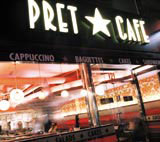Catering for the casual observer
As our tastebuds become more sophisticated, fast food retailers are upping the ante, says Trish Lorenz

Put the words fast and casual together and you probably think of sex. In fact, it’s the moniker created to define America’s fastest growing restaurant sector and it’s about to raise the pulse of British diners too.
One step up from fast food, the fast casual concept offers quick service and reasonably priced food with a focus on quality in a well designed environment. Primarily it targets the increasingly sophisticated tastes of baby boomers and those concerned with the health issues associated with fast food.
In the US, a number of fast casual concepts are experiencing phenomenal growth and industry estimates indicate the sector as a whole is worth more than £2.5billion in annual sales (source: Restaurants Hospitality US).
Britain has been slow to follow suit, but last week Pret A Manger, the doyenne of office lunches, opened the doors of Pret Café – an eat-in version of its sandwich store, which it hopes will outnumber the company’s original take-out concept over time.
Pret Café has been designed to entice customers to sit and eat and, although it will offer a similar menu to the main brand, it plans to increase portion size and further improve food quality. Price points around the £5 to £6 mark position it firmly below a ‘restaurant’ experience, but in-house-designed interiors are moving away from Pret’s functional stainless steel styling.
‘Pret A Manger [stores] sell quick takeaway food. Of our 150 shops, 90 per cent [of customers] take away, because the atmosphere – if you eat in – is dreadful. It’s not a place you’d sit in and eat. It’s like sitting in a washing machine,’ says Pret founder and creative director Julian Metcalfe.
Interiors at Pret Café, designed by Metcalfe and his three-strong internal design team, will be ‘radically different from Pret A Manger, much calmer, more sensuous and warmer, using softer materials like leather and wood and with good lighting’, he explains.
And though the cafés will be similar they won’t be identical. Features such as wallpaper and graphics will vary in each. ‘I hate chains, I think they’re insulting to customers,’ Metcalfe states. Initially, three to five café’s are planned, but Metcalfe has ambitious growth plans for the new concept.
Pret A Manger is not the first company to target this sector. Last summer Coffee Republic announced it was revamping its brand, becoming Republic Deli (DW 21 August 2003). Start-up concept Fresh Italy, designed by Pocknell Studio to appeal to disaffected fast food aficionados, also launched in July last year (DW 29 May 2003) and Aricot Vert is working with fledgling restaurant chain Frangos, specifically targeting the fast casual sector (DW 4 December 2003).
Frangos managing director Bruce Hodgson says fast casual is Source: Restaurants Hospitality USon the rise because fast food chains ‘were too inward looking’.
Their focus on other chains left the way open for supermarkets, coffee shops and now fast casual concepts to take market share by offering ‘honest food in great surroundings’, he maintains.
‘Consumer expectations have risen dramatically and the bombardment of food safety ads and food scares and the realisation that you don’t have to sit in a nasty environment means the mass mid-market is fed up with [fast food] chains,’ he says.
Fidelis Associates director Peter Buckley agrees. The group has worked with companies ranging from Pizza Hut to Harry Ramsden’s and it’s Buckley’s view that the ‘generic fast food style of restaurant design is almost tainted now, because [interiors] lack soul, comfort and warmth’.
‘People still want the comfort of knowing they can eat quickly, but they’re asking for atmosphere too,’ he says.
Fast food giant McDonald’s has acknowledged this trend. Last year the chain announced a series of renovations, aimed at moving some of its venues upmarket (DW 15 May 2003). Out went long-standing design features such as plastic tables and fluorescent lighting and in came wooden furniture, softer colour palettes and plasma screens.
The Formation creative director Adrian Kilby, who created branding for Republic Deli, agrees there is a gap in the market between sandwich bars and restaurants, which brands like Pret are well positioned to exploit.
‘Pret [comes from] an indulgent and sophisticated positioning and its brand perception is already one of quality, service and passion. Pret Café still focuses on what [the brand] does well and a concept like this allows it to broaden the catchment of people it can approach,’ Kirby claims.
But he is less convinced that McDonald’s will be able to make the move up. ‘[McDonald’s] product offer is very different and it’s a much harder leap to make,’ he says. ‘There’s very little indulgence associated with the brand.’
Buckley admits it will be difficult for fast food chains, but thinks they are on the right track. He suggests big brands like Pizza Hut will eventually launch sub-brands targeting specific niches, with the main brand fading into the background.
‘[Sub-branding] will enable them to change the style and décor. They’ll still own the restaurants, but will move away from the core brand,’ he believes.
Metcalfe’s passion and enthusiasm are renowned. Now back at the company’s helm and focused on driving the Pret Café format forward, it will be interesting to see if he can sway British fast food eating habits in the 21st century in the same way he revolutionised office lunches in the 1980s.
Fast Casual food the five criteria
• Limited service or self-service format
• A bill that averages between £4 and £6 per head
• Focus on quality, fresh food prepared to order
• Innovative food suited to sophisticated tastes
• Upmarket or highly developed interior design
-
Post a comment




